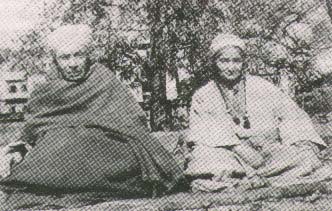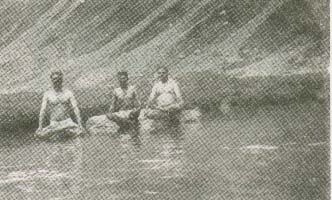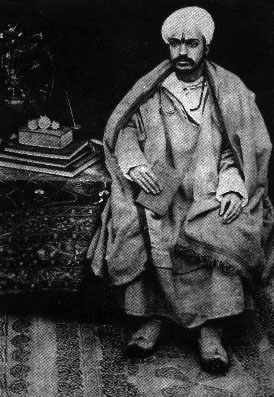Master Samsar
Chand Kaul
Great
Ornithologist of Kashmir
By Surender Kaul

Master Samsar Chand Kaul
Master
Samsar Chand Kaul (1883-1977) was a
renowned educationist, ornithologist and
environmentalist of his time, when subjects like
bird watching and study at natural history was
unknown in Kashmir. By profession, he was a
teacher in the then C. M. S. School at Fateh Kadal,
later Central High School, Srinagar, continuously
for 65 years and developed interest among the
students in the natural history around; besides
teaching of his usual academic subjects. His
keenness in inculcating aptitude among the
students towards glorious and everlastting
surroundings of mountains, birds, flowers and
forests was appreciated by the then British
Principal of the School, Mr. C.E. Tyndale Biscoe,
who, while writing a foreword to Master Samsar
Chand's book "Beautiful Valley of Kashmir
& Ladakh", wrote as under:
"I am most
grateful to Samsar Chand for having taught his
boys to love birds through his teaching of natural
history".
Illustrious
Teaching Career
His teaching career
in the C.M.S. School, was of highest educational
order. During his long span of teaching career, he
travelled to every nook and corner of the Valley
along with the students, both native as well as
foreign, and his colleagues. He scaled several
mountain peaks of Pir Panchal range like Mahadev,
Hurmokh and Kolahoi and undertook trekking
high-altitude lakes like Tarsar, Marsar, Gangabal,
Kolsar, Vishnu Sar, Kausar Nag, Sheeshram Nag, Har
Nag Valley and Kolahoi glacier, Har Bhagwan
glacier, Thajwas glacier, Botkul glacier and
Harmokh glacier, meadows like Toseh Maidan, Bungus,
Allapathar, Jamia Galli, Beasam Galli, Gureiz
Valley, stepped over boulders and rocks with the
students.
This close and
practical encounter with nature, in calm and
tranquil atmosphere, provided him with ample
opportunities to study, to know and to probe into
the history of nature and its geographical
transformation, which he happily shared with the
students accompanying him in these adventures. As
a teacher, he had developed his own methods of
imparting education. Even on mountains, hills and
meadows, he would explain to his students on the
spot the forms of fossils and their formation, he
would show the various types of rocks which he
came across during trekking or at camping sites.
In forest areas, he helped the students to
identify various kinds of trees by the shape of
their leaves and taught them how to calculate the
age of the trees by the number of annual tissue
rings in the trunks.

Pandit Samsar Chand Kaul
with his wife Lachchkuji in 1964.
Bird Watching as
Hobby
His principal area
of interest was ornithology, which needed immense
patience and perseverance. While on a picnic or in
a summer camp among the pine and fir trees in the
Valley, he would devote most of his time in
watching birds, their little ones, their art of
making nests and their melodious notes. He had
acquired, with the passage of time, experience to
imitate their chirping. For bird watching, he had
selected a few places in the Valley where he
invariably preferred to go in seasons. These
places were Hokursar, Anchar Lake, Feroze Nalla (Tangmarg),
vegetative strips of floating gardens in Dal Lake,
islets of dense willows and poplar trees - where
birds of all varieties, migratory and local, were
conspicuous by their presence. He would spend
hours there with a binocular to take close views
of birds in their nests or on branches of trees
and would immediately jot down his observations in
a note-book. Many bird watchers of world tame,
like late Saleem Ali from Bombay, joined him in
such experimentation in Anchar Lake as well as in
Dal Lake. Bird watching became his regular
activity and he kept his eyes open for birds in
high-altitude meadows and mountains during
trekking. In mountain ranges, he came across
Himalayan black bulbul, Himalayan whistling
thrust, Woodpecker, hoopoes, kingfisher, jungle
crow, sandpiper, turtle doves, red-bowed finch,
Himalayan brown dippler, Indian bushchat, blue
headed rock thrush, Stoliczka mountain finch and
mounttain pigeons.
Master Samsar Chand
had a flair for studying wild flowers, plants and
mountain herbs which he found during his trekking
in meadows and pastures in the mountainous ranges
of Kashmir. He made it a point to collect samples
of these wild flowers, herbs and plants, and would
carefully preserve them in between the leaves of
his diary in a scientific manner till his return
to his residence. These plants were later studied
with the help of expert professors of Botany. This
way he was able to identify many plants, flowers
and herbs during his trekking and would inspire
his students to explore and admire the floral
beauty. His collections included flowers like
Marino Longifolo, Morino Couterians, Dotentillo,
Anemone Tetrascaple, Primula Reptans, Primula
Rosea, fund Aquilegia Jueunda, Carydalis
Cashemirians, Astra Falconeri and herbs like
Indigoffera Lereantha, Sassurealappa, Artemisia,
Salviashien which were located in clusters on the
high mountain ridges. These herbal plants were
preserved by him in grass-made baskets at his home
and were gradually used for curing of joint pains,
skin diseases, cold and cough, etc.
Development of
Kobutar Khana
With the passage of
time, he developed acute interest for the
collection of so-called natural treasures and made
numberless visits to the remotest and inaccessible
areas of the Valley and collected a huge quantity
of flowers, herbs, fossil rocks, lime stone, drift
roots, plant leaves, hydro plants of lakes, bird
nests, egg shells of birds and feathers which were
preserved in a systematic manned in cupboards in
the school museum called Kobutar Khana. It was the
room where he taught geography. The room had been
converted into a full-fledged natural history
room. The ceiling of Kobutar Khana was covered
with large-sized paper with stars, galaxies,
planets, moon and constellations printed on its
sky-blue back- ground, which gave the impression
at a starry sky. Models of British ships like
Drudkot and Titanic were also kept in the museum.
A part of his
collections wars meticulously maintained by him in
large-sized albums at his residence in Motiyar,
Rainawari. Their characteristics, date and place
of procurement were skillfully and neatly written
below each sample. While skipping over the pages
of these albums, one would get so captivated, as
if one was actually loitering in the high
mountains of Kashmir. He would often take foreign
friends and his acquaintances around the school to
show them the museum developed and maintained by
him. Many foreign guests were deeply impressed by
his work and honoured him by nominating him as a
member of National Geographical Society,
Washington, Royal Geographical Society, Canada,
and Society of World Watchers, England, in late
1950s. His dedication and sincerity towards his
school and its students was so much that he would
pass on gift cheques, whenever received from
foreigners, to the school account for the welfare
and upkeep of the School.
As an Author
With such rich
experience of natural history and sound background
of the areas he travelled and trekked with
students and foreign nationals, he presented an
extensive vivid narration in lucid and facile
language in his most delightful books:
"Beautiful Valley of Kashmir & Ladakh",
"Birds of Kashmir" and "Srinagar
& Its Environ in 1940s."
He became an
authority on birds of the Valley and was often
called for programmes on birds by Radio Kashmir,
when Mr. P. C. Chatterjee was the Station
Director, AIR Kashmir, from 1955 onwards. He
delivered many talks on birds to foreign tourist
groups. His contribution in cultivating a habit
among boys for natural history and to develop a
sense of appreciation for beauty around them,
earned him a foreign travel across the Bay of
Bengal to Burma in 1935 at the expanses of the
school. His students understood the pains and
feelings of caged birds and dressed the wounds and
balmed the wounds of the birds and animals found
on the wayside.
Another glorious
suspect of his personality was his deep
involvement in spiritual pursuits. Compassion and
humanism were his hallmarks. He had imbibed the
traits of the missionary zeal by remaining hand in
glove with British people like late Mr. Tyndale
Biscoe, pioneer of education in Kashmir; his son,
Mr. Eric Biscoe; the late Col. A.E. Ward, the late
Jacob Sahib, Rev. R.D. Thompson; Dr. Smyth Morris;
Mr. B.D. Coventry, then Chief Conservator of
Forests and many others who visited Kashmir in the
pre-independettce period. He taught innumerable
poor boys and educated them without any kind of
remuneration in return and took to such selfless
path to satisfy his own inner conscience.
Besides being a
scholar of Kashmir Shaivism, Master Samsar Chand
was a noble soul totally devoted to God. Parikrama
of Hariparbat, followed by prayer and meditation,
were regular features of his daily life till his
lost breath. In the family, he guided his
grandchildren in learning Sanskrit mantras from
the scriptures before going to bed and entertained
them with stories from Bible, Hindu religious
scriptures and some interesting gleanings from
Rajtarangini or from Kashmir history, particularly
of Pathan rule which was dotted with clumsy whims
and fancies of Pathan Governors in the Valley.
Love for Outdoor
Life
He had wonderful
aesthetic tastes to enjoy life. In summer
vacation, when his school was closed, he would
plan programmes for outings along with his wife
and grandson. Visiting Khirbhawani was generally
preferred because of its being a secluded area
with spiritual grace and cool atmosphere of Chinar
trees. Here he found harmony and peace for his
spiritual exercises. Sometimes he also visited
health resorts like Achabal, Anantnag, Gautam Nag,
Nag Dandi and areas of old monument sites like
Kothyar Won, Parihaspore and Martand. He believed
that God was within one's self and did not feel
the need to roam about on pilgrimages in search of
God. In 1965, he went to Rishikesh, where he
attended the discourse of Swami Mahesh Yogi on
Vedanta. While listening to the discourse, he
stood up and sought Swamiji's permission to recite
a "shloka" from Utpalastutraveli, a book
on Kashmir Shaivism. Hailing Masterji's knowledge
of Shaivism, Swami Mahesh elucidated the aspect of
Kashmir Shaivism in detail to the gathering of
Indian and foreigners there. Though being a
student with Persian-Urdu background in his
graduation, yet Masterji had developed great
acumen for scientific knowledge and natural
history. He was also well versed in religious
philosophies and an exponent of Kashmir Shaivism.
His urge to learn Sanskrit made him a disciple of
learned Sanskrit teacher, late Shri Govind Joo
Bhatt of Rainawari, and enthusiastically joined
Gita classes on every Sunday at Vital Bhairav
Temple. Practical astronomy was his other field of
study and observation.
An Ardent
Star-Gazer
Kashmir is endowed
with lush green mountains, snow-capped peaks,
grating rivlets, gushing streams, dense forests,
cool breeze and a beautiful canopy of crystal blue
sky. The sky during the cover of darkness appears
like a vast umbrella studded with countless
glittering diamonds. On such starry nights,
Masterji used to point out various stars like
Great Bear, Polar Star, Milky Way and other
galaxies to his students while campings at
Gangabal, Sonamarg or Gulmarg and wold narrate
details about these planets to students.
Despite having attained
expertise and excellence in ornithology, Master
Samsar Chand Koul could not get due recognition
either from J&K Government or from the Centre.
Leading political men and personalities of the
state, like late Bakshi Ghulam Mohd., G. M. Sadiq,
Agha Showkat, former diplomat in Pakistan, Agha
Ashraf, P. N. Jalali, Bashir Bakshi, Dr. Nassir
Shah, late Prof. M. S. Want and Prof. Ansari were
some of his distinguished students in C.M.S.
School.
However, the British
Government favoured him with the honour of a small
war pension; but in the state where he gave wider
dimension to the education of the students, he
passed away in oblivion.

Master Samsar Chand
Kaul (extreme left) with his CMS School colleagues
Sarvashri Jialal Katal
and Isher Kaul at Tarsar Marsar Lake in 1939.
[ The author is Master
Samsar Chand's grandson and resides in 128/13,
Sector I, Pushp Vihar, New Delhi. ]
Source: Koshur
Samachar
|

















No one has commented yet. Be the first!